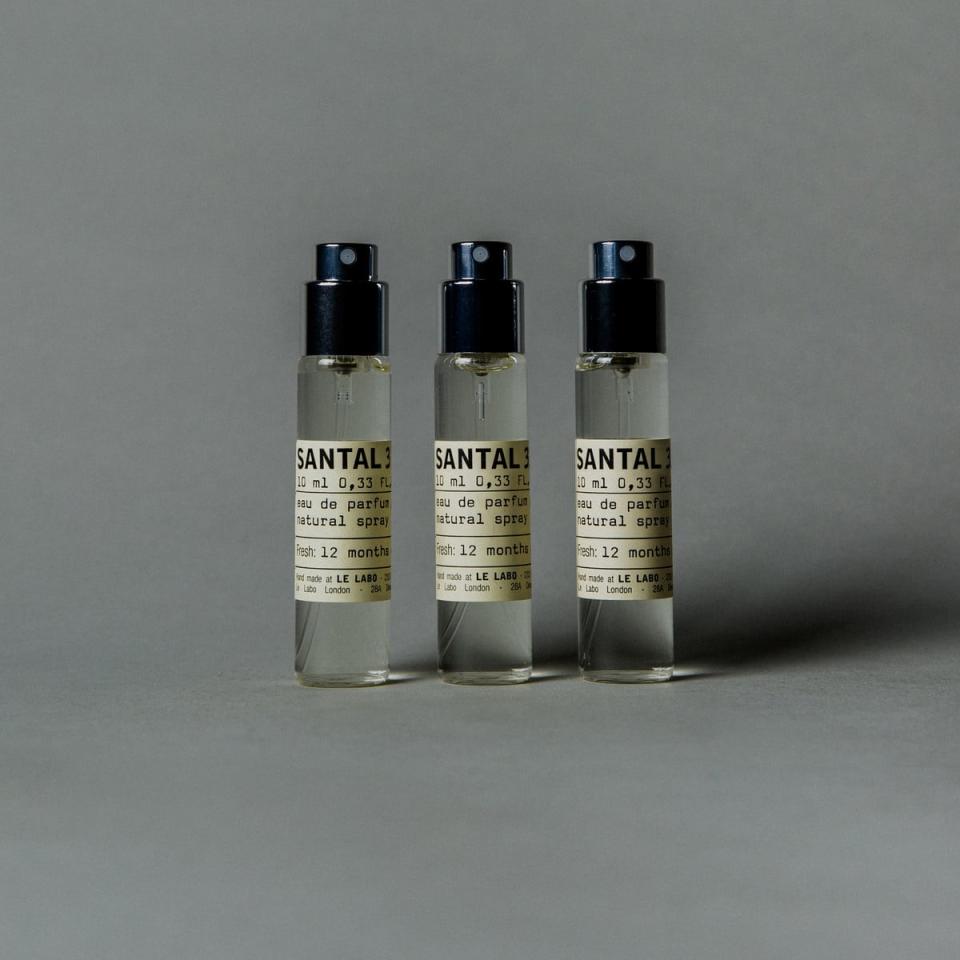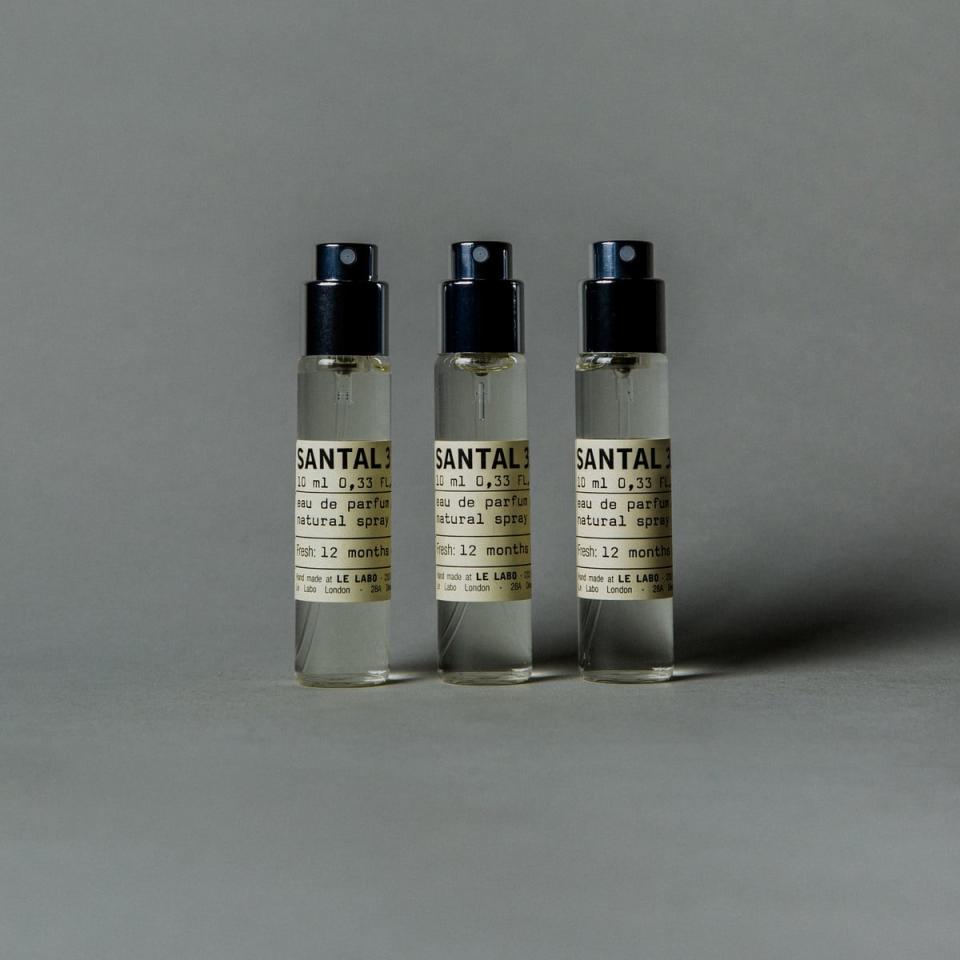Le Labo Santal 33: The Scent That Went From Ruggedly Cool to Utterly Basic
Will we ever escape the enduring ubiquity of fashion's favorite cult fragrance?
Everyone — and everything — smells like Santal 33. Or, rather, Santal 33 smells like everyone and everything. In 2015, The New York Times dubbed the cult scent, produced by Estée Lauder Companies-owned perfume brand Le Labo, "that perfume you smell everywhere," by which point it was already considered novel not to smell like the blend of sandalwood, cedarwood, cardamom, iris, violet and ambrox. Its woodsy smoke had already filled nearly every metropolitan bar, hotel lobby, and boardroom, long overstaying its welcome. And yet, as recently March of 2017 — when this very publication polled those working in the fashion and beauty industries about their signature scents — it claimed an inevitable spot. Its cult-like status, it seems, has only continued to grow.
Though it's now difficult to recall a time when SoHo wasn't filled with errant whiffs of the instantly recognizable aroma, Santal has only been around since 2011. Le Labo was inspired by both its preexisting, similar-smelling candle, Santal 26, and the rugged Marlboro Man ads from the latter half of the 20th century. In a press release, the perfumery described Santal 33 utilizing the romanticism of the early American west: "An open fire… The soft drift of smoke… Where sensuality rises after the light has gone," decidedly masculine descriptors for a unisex scent that would come to represent the smell of the social and fashion elite.
Early reviews noted Santal 33's intoxicating initial, woody notes and bemoaned its later loss of "cowboy bravado" as it wore on your skin. Additionally and somewhat curiously, many reviewers compared the scent to pickle juice. Maybe because of the fragrance's more feminine leanings and its association with luxury, the gaucho sheen quickly faded. Instead, it became the calling card for "everyone in L.A.," moms dropping off their kids at school, writers exclaiming "I wanted my entire life to smell like it," and a slew of upscale hotel lobbies.
Over the course of its eight-years-and-counting lifespan, Santal has served as the ever-present scent for many sumptuous experiences: Edition Hotels stocks the stuff in rooms throughout the world, as does New Orleans' Pontchartrain Hotel and Pulitzer Amsterdam. Austin's Saint Cecilia no longer uses the scent in its rooms, but it did for a time. New York's PUBLIC Hotel spritzes Santal throughout its common areas, meaning the entire space pretty much reeks of the stuff. Meanwhile, New York, Hollywood and Miami's 1 Hotels are filled with a "custom" Le Labo scent that is undeniably similar to Santal 33.
Not just for fancy spaces but fancy people, Los Angeles T-shirt brand Hiro Clark sold a scented top infused with — you guessed it — Santal 33; eco-friendly fabric care company The Laundress collaborated with Le Labo for a Santal 33 detergent for those attracted to the notion of steeping every aspect of their lives in the trendy perfume.
Santal 33's omnipresence as the signature scent of both waifish fashion buyers and bored office workers alike is an impressive feat. But as a result of this complete and inescapable ubiquity, the perfume has devolved into the "pumpkin spice latte of fragrances," as one Redditor so aptly put it. No longer an aroma that holds any special meaning — it's everywhere, after all — it has come to represent nothing.
When millennial society struggles to distance itself from the caricature of depressed shells of humanity attached to their phones, why cop out on a scent that's the aromatic equivalent? Why smell like a crowded basement bar in a hip hotel? Why mask your originality in banality?
The perfume is the fragrant embodiment of filler words such as "like" and "um," good for dressing up emptiness and likely why it's become so popular within the hotel lobby market. However, when every space, from trendy bars to subway cars, smells the same, there is little distinction between the lifestyle we are supposed to covet and everyday happenstance.
Fragrance, after all, is about aspiration, smelling like the person we want to be. Who are we then if we all smell the same? What differentiates our goals or our own supposedly envious lifestyles from our cubicle mate's when we all smell like an overpriced T-shirt? As if somehow comforted by the fact that one wears an "It-girl" scent, placing you leaps and bounds higher on the social ladder than the Body by Victoria's Secret-favorers, remaining devoted to Santal 33 means coming to terms with the false confidence brought on by the belief of making an original choice.
In a few years' time, Santal 33 will come to represent the collective memories of a generation — of that hotel in London, that comedy show in Manhattan, all those faceless people you can't remember. The same flashbacks triggered by the same notes. There will be no shortage of anecdotes to share when you catch a whiff of Santal 33 on the street, which makes its far-reaching appeal all the more notable. The aroma is a point of commonality, and it may just remind you of a trendy shop or a yoga class instead of a more landmark moment.
Santal 33's original mission was to remind us of the prairie, nights by the fire. Le Labo wanted us to bring this rustic mystique back to our respective urban corners, leaving a trail of coolness in our wake. And for a time, it succeeded. But eventually, its ubiquitousness has come to define a boutique lifestyle, an in-the-know badge of honor, and leaving wearers dressed in the school uniform equivalent of perfume.
Of course, there is nothing wrong with wearing and loving Santal 33 if Santal 33 is truly your soul-serving scent. Perfume should make you feel happy and generally good, and there's no doubt that Le Labo's most infamous eau does exactly that for scores of people who wear it. It's hardly unappealing, but like an inoffensive pop song overplayed on every radio station, its constance is grating. But maybe a more adventurous path awaits, one where your alter ego smells like a dark night after a rainstorm, mysterious and musky, or like a dainty slip dress on a summer afternoon, bright and sensual, instead of smelling like, well, everyone else.
Homepage/main photo: Courtesy of Le Labo


